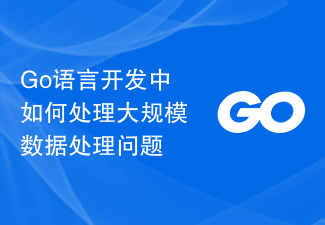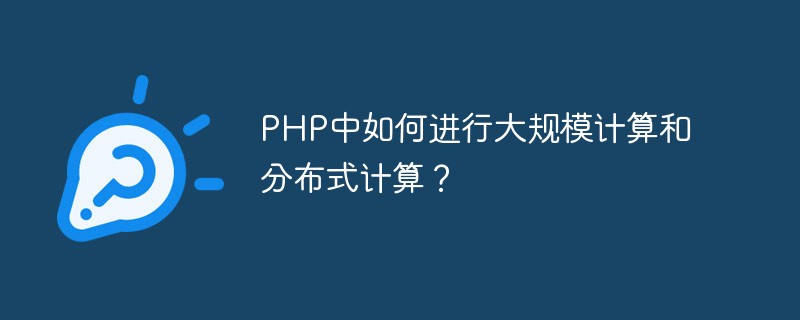
Master the concurrency mode and distributed computing of Go language
Go language is an open source programming language developed by Google. It is known for its simplicity, efficiency, and powerful concurrency performance, and is widely used to build high-performance network services and distributed computing systems. This article will introduce the concurrency mode of Go language and how to use it for distributed computing.
In the Go language, the main way to achieve concurrency is through goroutine and channel. Goroutine is a lightweight thread, and thousands of goroutines can be run simultaneously in the Go language. By creating goroutines, multiple tasks can be executed simultaneously, thereby improving the concurrency performance of the application. Channel is a mechanism used for communication between goroutines.
Efficient concurrent programming can be achieved by decomposing tasks into multiple goroutines and using channels for communication. For example, a common application scenario is to crawl web content and process it simultaneously. You can create a goroutine to request web page content, and then send the obtained data to the processing goroutine for parsing and storage.
The following is a simple sample code that demonstrates how to use goroutine and channel to implement the function of concurrently crawling web content:
package main
import (
"fmt"
"net/http"
)
func fetch(url string, ch chan<- string) {
resp, err := http.Get(url)
if err != nil {
ch <- fmt.Sprint(err)
return
}
defer resp.Body.Close()
ch <- fmt.Sprintf("Fetched %s", url)
}
func main() {
urls := []string{"http://www.google.com", "http://www.baidu.com", "http://www.sina.com"}
ch := make(chan string)
for _, url := range urls {
go fetch(url, ch)
}
for range urls {
fmt.Println(<-ch)
}
}In the above code, the fetch function is used to obtain web content , and send the result to the channel. In the main function, by using goroutine and channel, multiple fetch requests can be initiated at the same time and the results can be printed after receiving them.
In addition to concurrent programming, the Go language also provides some libraries and tools for implementing distributed computing. One of the important tools is the rpc package that comes with the Go language, which provides a simple and powerful RPC (remote procedure call) framework.
Using the rpc package, you can easily build a distributed computing system. Developers only need to define the service interface and implementation, and then use the rpc.Register function to register the service to the RPC server. Next, the client can connect to the RPC server through the rpc.Dial function and call the registered service method to implement distributed computing.
The following is a simple sample code that demonstrates how to use the rpc package for distributed computing:
package main
import (
"fmt"
"net"
"net/rpc"
)
type MathService struct{}
func (m *MathService) Multiply(args *[]int, reply *int) error {
*reply = (*args)[0] * (*args)[1]
return nil
}
func main() {
mathService := new(MathService)
rpc.Register(mathService)
l, err := net.Listen("tcp", ":1234")
if err != nil {
fmt.Println(err)
return
}
for {
conn, _ := l.Accept()
go rpc.ServeConn(conn)
}
}In the above code, we define a MathService structure, which contains a Multiply method. This method is used to receive two integers and store the result of their multiplication in the reply pointer. Next, we use the rpc.Register function to register the MathService on the RPC server. Finally, the client's request is processed by calling the rpc.ServeConn function.
On the client side, you can connect to the RPC server through the rpc.Dial function and call the service method to obtain the results.
The concurrency model and distributed computing capabilities of the Go language make it an ideal choice for building high-performance, scalable distributed systems. By mastering concurrent programming and utilizing the rpc package, developers can more easily implement concurrent tasks and distributed computing logic. Whether building network services or distributed computing systems, mastering the concurrency model and distributed computing technology of the Go language is an important skill for developers.
The above is the detailed content of Master the concurrency mode and distributed computing of Go language. For more information, please follow other related articles on the PHP Chinese website!
 使用golang框架如何进行分布式计算?Jun 03, 2024 pm 10:31 PM
使用golang框架如何进行分布式计算?Jun 03, 2024 pm 10:31 PM使用GoLang实现分布式计算的分步指南:安装分布式计算框架(如Celery或Luigi)创建封装任务逻辑的GoLang函数定义任务队列将任务提交到队列设置任务处理程序函数
 如何在Python中实现一个分布式计算框架,以及任务调度和结果收集的机制和策略Oct 19, 2023 am 10:16 AM
如何在Python中实现一个分布式计算框架,以及任务调度和结果收集的机制和策略Oct 19, 2023 am 10:16 AM标题:Python中的分布式计算框架实现及任务调度与结果收集机制摘要:分布式计算是一个有效利用多台计算机资源来加速任务处理的方法。本文将介绍如何使用Python实现一个简单的分布式计算框架,包括任务调度和结果收集的机制与策略,并提供相关代码示例。正文:一、分布式计算框架的概述分布式计算是一种利用多台计算机共同处理任务而达到加速计算的目的。在分布式计算框架中,
 Go语言开发中如何处理大规模数据处理问题Jun 29, 2023 pm 05:49 PM
Go语言开发中如何处理大规模数据处理问题Jun 29, 2023 pm 05:49 PMGo语言作为一门高效、并发性强的编程语言,逐渐在大规模数据处理领域得到了广泛的应用。本文将探讨在使用Go语言进行大规模数据处理时,如何处理相关的问题。首先,对于大规模数据的处理,我们需要考虑数据的输入和输出。在Go语言中,文件读写模块提供了丰富的功能,可以轻松地实现数据的读取和写入。当处理大规模数据时,我们可以选择按行读取数据,逐行进行处理,这样可以避免一次
 golang并发模式下函数缓存设计与实现May 01, 2024 pm 02:33 PM
golang并发模式下函数缓存设计与实现May 01, 2024 pm 02:33 PM为了在Go的并发环境中实现函数缓存,可以遵循以下步骤:定义一个包含Get和Set方法的Cache接口。使用sync.Map实现一个syncMapCache结构,它实现了Cache接口并存储缓存数据。为不同的函数注册缓存处理函数。利用sync.MapCache,可以缓存函数计算结果,例如斐波那契数列,有效地提升程序性能。
 PHP中如何进行大规模计算和分布式计算?May 22, 2023 pm 09:10 PM
PHP中如何进行大规模计算和分布式计算?May 22, 2023 pm 09:10 PM随着互联网的不断发展,Web应用程序的规模越来越大,需要处理更多的数据和更多的请求。为了满足这些需求,计算大规模数据和分布式计算成为了一个必不可少的需求。而PHP作为一门高效、易用、灵活的语言,也在不断发展和改进自身的运行方式,逐渐成为计算大规模数据和分布式计算的重要工具。本篇文章将介绍PHP中大规模计算和分布式计算的概念及实现方式。我们将讨论如何使用PHP


Hot AI Tools

Undresser.AI Undress
AI-powered app for creating realistic nude photos

AI Clothes Remover
Online AI tool for removing clothes from photos.

Undress AI Tool
Undress images for free

Clothoff.io
AI clothes remover

AI Hentai Generator
Generate AI Hentai for free.

Hot Article

Hot Tools

Zend Studio 13.0.1
Powerful PHP integrated development environment

EditPlus Chinese cracked version
Small size, syntax highlighting, does not support code prompt function

Dreamweaver Mac version
Visual web development tools

Atom editor mac version download
The most popular open source editor

mPDF
mPDF is a PHP library that can generate PDF files from UTF-8 encoded HTML. The original author, Ian Back, wrote mPDF to output PDF files "on the fly" from his website and handle different languages. It is slower than original scripts like HTML2FPDF and produces larger files when using Unicode fonts, but supports CSS styles etc. and has a lot of enhancements. Supports almost all languages, including RTL (Arabic and Hebrew) and CJK (Chinese, Japanese and Korean). Supports nested block-level elements (such as P, DIV),









